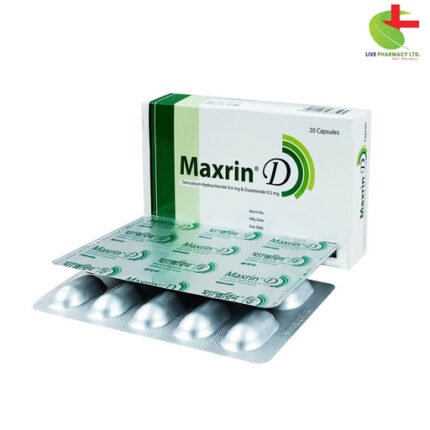Tetrax 500
33.90৳ Strip
- Tetrax: A versatile antibiotic from the tetracycline group
- Effective against various bacterial infections like pneumonia, UTIs, and acne vulgaris
- Mechanism involves inhibiting bacterial protein synthesis for broad-spectrum coverage
- Contraindicated in patients with specific allergies and renal impairments
- Important to consider interactions and potential side effects for safe usage
 Brand
Brand
|
Square Pharmaceuticals PLC |
|---|---|
 Generics
Generics
|
Tetracycline Hydrochloride |
Indications
Tetrax is the preferred treatment for the following infections:
- Rickettsial infections (such as Rocky Mountain spotted fever, endemic and scrub typhus fever, and human ehrlichiosis).
- Mycoplasma pneumoniae infections in adults. These outbreaks of pneumonia, commonly found in barracks and institutions, mostly affect children and young adults. While rare, maculopapular rashes, hemolytic anemia, and meningoencephalitis may occur.
- Chlamydial infections, including Chlamydia psittaci, which causes psittacosis (ornithosis), a systemic illness contracted from infected birds. This infection may lead to extensive pneumonia and severe systemic upset, with headache as a prominent early symptom.
- Non-gonococcal or nonspecific urethritis, referring to inflammation of the urethra not caused by gonococcal, chlamydial, or other specific infectious agents.
- Lyme disease
- Brucellosis
- Miscellaneous infections such as granuloma inguinale, cholera, glanders, relapsing fever, and V. vulnifians.
Other common uses of tetracycline include:
- Urinary tract infections caused by susceptible organisms, including acute urethral syndrome in women.
- Bronchitis in patients with known underlying chronic lung diseases.
- Pelvic inflammatory disease and other sexually transmitted diseases (STDs) regimens.
- Traveler’s diarrhea.
- Acne vulgaris
- Prostatitis.
- As an alternative agent in penicillin-allergic patients with syphilis.
- Anaerobic infections caused by susceptible organisms.
Pharmacology
Tetracycline primarily acts on protein synthesis, with an energy-dependent active transport system facilitating its entry into bacterial cells. Within the cell, it binds specifically to the 30s ribosomes, inhibiting bacterial protein synthesis.
While many Gram-positive aerobic cocci are susceptible, resistance is common among staphylococci, streptococci, and some pneumococci. Tetracycline is not the preferred choice for infections caused by Gram-positive aerobes.
Pseudomonas and many Enterobacteriaceae are resistant to tetracycline. However, it remains effective against some community-acquired E. coli strains, making it suitable for uncomplicated initial UTIs. Tetracycline is also the drug of choice for Brucella species, Calymmatobacterium granulomatis, Vibrio cholerae, and V. vulnificus.
Tetracycline exhibits activity against anaerobic bacteria, and its high concentrations in the gastrointestinal tract can alter the enteric flora.
Dosage & Administration
The typical adult oral dosage of tetracycline is 1-2 g daily, administered in 2-4 divided doses. For children over 8 years old, the recommended dosage is 25-50 mg/kg daily, also given in divided doses.
Tetracycline should preferably be taken one hour before or two hours after meals.
Specific dosing recommendations for various indications include:
- Acne vulgaris: 250 mg four times daily or 500 mg every 12 hours for one week; followed by 125-250 mg daily for several weeks or months, based on individual progress.
- Acute staphylococcal infections: 1-2 g daily in divided doses for 10-14 days.
- Acute streptococcal infections: 1-2 g daily in divided doses for 10 days. Prolonged therapy is necessary to prevent rheumatic fever or glomerulonephritis.
- Amoebiasis: 1 g daily in four divided doses or 500 mg every 12 hours for 7 days, in combination with amoebicidal agents.
- Brucellosis: 500 mg four times daily plus 1 g streptomycin twice daily for one week; followed by 500 mg four times daily (without streptomycin) for another week. Prolonged therapy is required to prevent relapse.
Interaction
Absorption may be impaired when tetracycline is taken with antacids containing divalent and trivalent cations (e.g., Al, Ca, Mg), iron (Fe), zinc (Zn), sodium bicarbonate preparations, kaolin-pectin, bismuth subsalicylate, sucralfate, strontium ranelate, colestipol, and colestyramine. It may also interfere with the bactericidal action of penicillin, potentiate the effect of anticoagulants, and decrease the efficacy of oral contraceptives. Nephrotoxic effects could worsen when combined with diuretics or other nephrotoxic drugs. Additionally, tetracycline may increase the hypoglycemic effect of insulin and sulfonylureas in patients with diabetes mellitus and enhance the toxic effects of ergot alkaloids and methotrexate.
Contraindications
Tetracycline Hydrochloride is contraindicated in patients hypersensitive to any member of the tetracycline group, as cross-sensitivity may occur. It should be avoided in patients with systemic lupus erythematosus. In cases of renal impairment, particularly if severe, tetracycline hydrochloride is considered contraindicated; if necessary, doses should be reduced.
Side Effects
- Teeth and bone: Tetrax may cause depression of bone growth, permanent gray-brown discoloration of the teeth, and enamel hypoplasia when administered during tooth development (i.e., during the latter half of pregnancy, infancy, and childhood).
- Hypersensitivity reactions such as anaphylaxis, urticaria, and rashes are uncommon. Photosensitivity reactions, characterized by a red rash on areas exposed to intense sunlight, can occur with Tetrax.
- Gastrointestinal effects: Epigastric distress and nausea are commonly observed after oral administration, with symptoms somewhat dose-related. Vomiting may occur.
- Accentuated prerenal azotemia: Tetrax may exacerbate pre-existing renal failure by inhibiting protein synthesis, leading to increased azotemia from amino acid metabolism.
- Superinfections with oral and anogenital candidiasis are relatively common in patients taking Tetrax.
- Esophageal ulcerations: In most cases, patients who developed esophageal ulcerations were taking capsules with little or no fluid before bedtime. To minimize this risk, oral doses should be administered with adequate fluid intake.
Pregnancy & Lactation
Tetracycline should be avoided during pregnancy due to the risk of hypertoxicity in the mother and adverse effects on fetal development. Its use during breastfeeding and in children up to 8 (some authorities suggest 12) years of age may result in impaired bone growth and permanent discoloration of the child’s teeth.
Precautions & Warnings
Caution should be exercised when administering Tetrax to patients with impaired liver function, and high doses should be avoided. Concomitant use with potentially hepatotoxic drugs (including erythromycin, chloramphenicol, isoniazide, and sulphonamides) should be avoided.
Therapeutic Class
Tetracycline belongs to the therapeutic class of tetracycline group of drugs.
Storage Conditions
Store Tetrax between 20-25°C.













Reviews
There are no reviews yet.